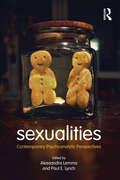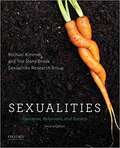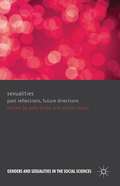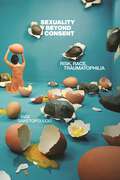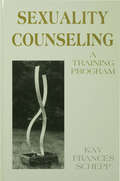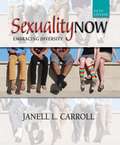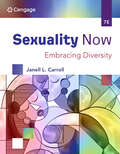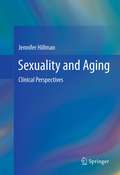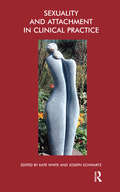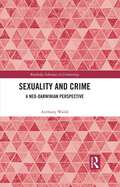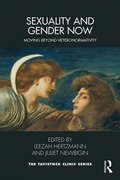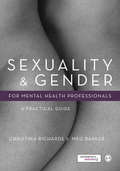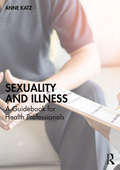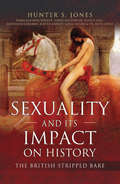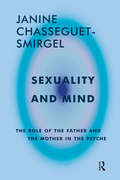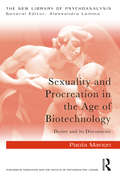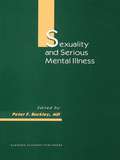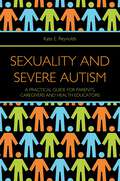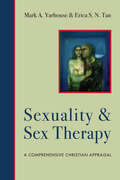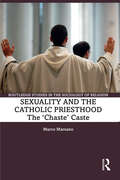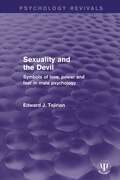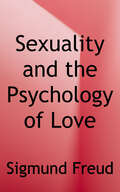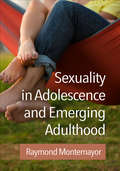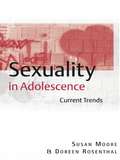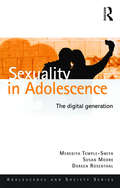- Table View
- List View
Sexualities: Contemporary Psychoanalytic Perspectives
by Alessandra Lemma Paul E. LynchSexualities: Contemporary Psychoanalytic Perspectives presents a broad selection of contemporary psychoanalytic thinking on sexuality from a wide range of psychoanalytic traditions. Sexuality remains at the heart of much psychoanalytic theory and practice but it is a complex and controversial subject. Edited by Alessandra Lemma and Paul E. Lynch, this volume includes a range of international contributions that examine contemporary issues and trace common themes needed to understand any sexuality, including the basics of sexuality, and the myriad ways in which sexuality is lived. The clinical examples provided here demonstrate contemporary psychoanalytic techniques that uncover meanings that are both fresh and enlightening, and address heterosexuality, homosexuality, gender, and perversion from a psychoanalytic perspective. Divided into four parts, the book includes the following: Historical context Foundational concepts: Contemporary elaborations Homosexuality Perversion revisited Throughout Sexualities: Contemporary Psychoanalytic Perspectives the reader will find psychoanalytic wisdom that is transferrable to work with patients of all sexualities, and will see that the essentials of sexuality may be more similar than they are different for homo- and hetero-sexuality. Psychoanalysts and psychoanalytic psychotherapists, as well as academics interested in the subjects of psychoanalysis, gender, sexuality, or homosexuality will find this book an invaluable resource. Alessandra Lemma, PhD is Director of the Psychological Therapies Development Unit at the Tavistock and Portman NHS Foundation Trust. She is a Fellow of the British Psychoanalytic Society and Visiting Professor in the Psychoanalysis Unit, University College London. She is a Consultant Adult Psychotherapist at the Portman Clinic where she specializes in working with transsexuals. She has published extensively on psychoanalysis, the body and trauma. Paul E. Lynch, MD is on the faculty of the Boston Psychoanalytic Society and Institute, the Massachusetts Institute for Psychoanalysis, and the China American Psychoanalytic Alliance. He teaches about psychoanalysis, gender, and sexuality, and has been a popular speaker on issues of homosexuality and psychoanalysis. He is also a Clinical Instructor of Psychiatry at the Tufts University School of Medicine.
Sexualities: Identities, Behaviors, And Society
by Michael Kimmel The Stony The Stony Brook Sexualities Research GroupThis anthology on sexuality addresses such key questions as: How are sexualities socially constructed? Why are sexualities more than just natural "urges"? and How are sexualities personal, social, and political? Using multiple disciplines, international populations, and theories to explore sexualities, it opens with classical and contemporary theories, and then explores the ways in which we learn about sexual activities and develop sexual identities. Sexualities: Identities, Behaviors, and Society has a strong sociological approach, but also considers other important perspectives (psychology, biology, history). It is rigorous, yet accessible and engaging, covering classical and contemporary arguments and perspectives.
Sexualities: Past Reflections, Future Directions
by Yvette Taylor Sally HinesThis collection examines recent theoretical and methodological debates, shifts in law and policy, and social and cultural changes around sexuality. It sets out new ways of conceptualizing and researching sexuality and explores persistently marginalised and re-traditionalised sexual practices, subjectivities and identities.
Sexuality Beyond Consent: Risk, Race, Traumatophilia (Sexual Cultures)
by Avgi SaketopoulouRadical alternatives to consent and traumaArguing that we have become culturally obsessed with healing trauma, Sexuality Beyond Consent calls attention to what traumatized subjects do with their pain. The erotics of racism offers a paradigmatic example of how what is proximal to violation may become an unexpected site of flourishing. Central to the transformational possibilities of trauma is a queer form of consent, limit consent, that is not about guarding the self but about risking experience. Saketopoulou thereby shows why sexualities beyond consent may be worth risking-and how risk can solicit the future.Moving between clinical and cultural case studies, Saketopoulou takes up theatrical and cinematic works such as Slave Play and The Night Porter, to chart how trauma and sexuality join forces to surge through the aesthetic domain. Putting the psychoanalytic theory of Jean Laplanche in conversation with queer of color critique, performance studies, and philosophy, Sexuality Beyond Consent proposes that enduring the strange in ourselves, not to master trauma but to rub up against it, can open us up to encounters with opacity. The book concludes by theorizing currents of sadism that, when pursued ethically, can animate unique forms of interpersonal and social care.
Sexuality Counseling: A Training Program
by Kay Frances ScheppFirst published in 1986. Routledge is an imprint of Taylor & Francis, an informa company.
Sexuality Now: Embracing Diversity
by Janell L. CarrollThe new edition continues answering the questions and concerns that readers have about themselves and their sexuality with scientific fact, sensitivity, humor, and unmatched candor. Carroll presents the range of sexual orientations and behaviors and takes into account the current social, religious, ethnic, racial, and cultural contexts. This edition includes even more examples and research on sexual diversity both within and across cultures.
Sexuality Now: Embracing Diversity
by Janell L. CarrollCaroll's SEXUALITY NOW: EMBRACING DIVERSITY, 7th Edition, takes a refreshing and contemporary approach to teaching human sexual behavior. With a balance of foundational biological concepts and new, groundbreaking research, the book provides all the essential information students need and want to know about sexuality, combining scientific accuracy, sensitivity, humor and honesty. This edition offers a comprehensive exploration of diverse sexual orientations and gender identities, thoughtfully considering the impact of social, religious, ethnic, racial, socioeconomic and cultural backgrounds on today’s students. MindTap provides a unique opportunity to gain insights from Dr. Carroll’s global interviews with individuals, offering varied perspectives on topics in human sexuality. Cengage Infuse is the first and only embedded course kit that lives inside your Learning Management System (LMS).
Sexuality and Aging
by Jennifer HillmanDespite continuing ageist beliefs that sexuality is a privilege designed only for the young and physically healthy, research continues to indicate that the majority of older adults maintain interest in sexuality and may engage in fulfilling sexual behavior well into their last decade of life. Unfortunately, many professionals remain unaware of general knowledge of elderly sexuality, including the expected and normal physiological changes that can occur within the context of both male and female aging. The presence of chronic illness and other medical problems certainly can influence the expression of an aging adult's sexuality, and emergent research suggests that there are effective ways to cope with menopause, heart disease, arthritis, incontinence, diabetes, sleep disorders, breast cancer, prostate cancer, and erectile dysfunction (ED), among others. Dramatic changes have taken place within the last decade alone in terms of non-surgical treatment for incontinence and ED, with forms of sex therapy, biofeedback, and PDE-5 inhibitors. Regrettably, many aging adults and their care providers remain unaware of their increased risk factors for STDs, including HIV infection via lack of knowledge, changes in the vaginal lining, and typical declines in immune function. Estimates suggest that by the year 2020, more than half of all individuals living with HIV will be over the age of 50. Although some high quality professional books are available for clinicians, they tend to be disjointed research bibliographies, edited volumes on a narrowly focused aspect of elderly sexuality, or texts that are more than 10 years old. With the extent of new information available regarding sexuality and aging, an up to date, empirically based text is necessary.
Sexuality and Attachment in Clinical Practice (The Bowlby Centre Monograph Series)
by Kate White Joseph SchwartzThis book is a selection of papers from the eleventh John Bowlby Memorial Conference. It covers the themes of sexuality and attachment, providing from a historical overview through intricate theoretical pathways to vivid descriptions to both analyst and analysand of a therapeutic relationship.
Sexuality and Crime: A Neo-Darwinian Perspective (Routledge Advances in Criminology)
by Anthony WalshWritten by one of the leading figures in biosocial criminology and evolutionary psychology, this work explores the tight relationship between criminality and indiscriminate sexuality within the framework of life history theory. The underlying thesis is that traits associated with a strong libido, indiscriminately expressed, are intertwined with traits associated with criminal behavior; that is, excessive interest in sexual adventures pursued in an irresponsible way is undergirded by the same individual short- run hedonistic traits that define criminality. While traditional criminology tends to view sexual and criminal behavior as separate domains, many biosocial criminologists, evolutionary psychologists, neuroscientists, and behavioral and molecular geneticists are not at all surprised that a link exists between criminality and sexuality. Research shows that the statistical relationship between indiscriminate sexuality and criminal behavior is stronger than for most other variables associated with crime, although most studies dealing with this relationship are from outside the dominant environmentalist paradigm of criminology. Using life history theory as the theoretical umbrella for exploring the relationship between indiscriminate sexuality and criminal behavior, the book explores how and why criminal behavior is related to hypersexuality. Life history theory, which has a long and fruitful history of use among evolutionary biologists who use it to investigate the relationship between mating strategies and the environment among various species of animals (including humans) is particularly suited to understanding how an exclusive focus on mating effort is related to criminal behavior. This book will be of interest to scholars and students in criminology, psychology, and sociology, and anyone interested in examining the interconnection between biological, psychological, and socio- environmental factors in relation to criminal behavior.
Sexuality and Gender Now: Moving Beyond Heteronormativity (Tavistock Clinic Series)
by Leezah Hertzmann Juliet NewbiginSexuality and Gender Now uses a psychoanalytic approach to arrive at a more informed view of the experience and relationships of those whose sexuality and gender may not align with the heterosexual "norm". This book confronts the heteronormative bias dominant in psychoanalysis, using a combination of theoretical and clinical material, offering an important training tool as well as being relevant for practicing clinicians. The contributors address the shift clinicians must make not only to support their patients in a more informed and non-prejudicial way, but also to recognise their own need for support in developing their clinical thinking. They challenge assumptions, deconstruct theoretical ideas, extend psychoanalytic concepts, and, importantly, show how clinicians can attend to their pre-conscious assumptions. They also explore the issue of erotic transference and countertransference, which, if unaddressed, can limit the possibilities for supporting patients more fully to explore their sexuality and gender. Theories of psychosexuality have tended to become split off from the main field of psychoanalytic thought and practice or read from an assumed moral high ground of heteronormativity. The book specifically addresses this bias and introduces new ways of using psychoanalytic ideas. The contributors advocate a wider and more flexible attitude to sexuality in general, which can illuminate an understanding of all sexualities, including heterosexuality. Sexuality and Gender Now will be essential reading for professionals and students of psychoanalysis who want to broaden their understanding of sexuality and gender in their clinical practice beyond heteronormative assumptions.
Sexuality and Gender for Mental Health Professionals: A Practical Guide
by Dr Meg Barker Christina RichardsQuestions of sexuality and gender affect everyone and therefore have an inevitable relevance in the consulting room. Yet with interpretations and manifestations of both varying greatly from person to person, understanding the inherent complexities of sexuality and gender can be a daunting task for the health professional. Breaking down these complexities this practical guide familiarises the reader with all of the common and many of the less common sexualities, genders and relationship forms, and explains experiences and issues relating to each. The book contains: -Explanations of various forms of sexuality, gender and relationship structures -Common concerns relating to specific groups -Key practises relating to specific groups -The treatment of specific groups in contemporary Western society -Details of some rules and ideals that are commonly found within specific groups -Suggestions for professional practice with these groups Ideal for all members of the multidisciplinary team, this accessible book is relevant to practitioners across theoretical backgrounds. Whether you are a trainee or qualified psychotherapist, counsellor, nurse, medic, psychiatrist, social worker or applied psychologist, this is a vital text for your professional practice. CHRISTINA RICHARDS is Senior Specialist Psychology Associate at the West London Mental Health NHS Trust (Charing Cross) Gender Identity Clinic. MEG BARKER is a senior lecturer in psychology at the Open University and a sex and relationship therapist.
Sexuality and Illness: A Guidebook for Health Professionals
by Anne KatzThis evidence-based guide educates and informs health professionals about promoting sexual wellbeing in the context of challenges from physical and mental health. Sexuality is an important aspect of quality of life for many people but can be affected by a wide variety of health conditions, such as cardiovascular disease, mental illness, menopause, diseases of ageing, neurological diseases and spinal cord injuries, combat injuries, and cancer. Building readers’ confidence in initiating and encouraging open communication on this often-neglected topic, Sexuality and Illness includes case studies that illustrate how to talk about sexuality and support patients with concerns about it. Making recommendations for practice and further reading, it takes into account gender, sexual, race and ethnic diversity. This accessible text demystifies a topic that is sometimes difficult to discuss. It is essential reading for healthcare practitioners interested in providing comprehensive and person-centred care.
Sexuality and Its Impact on History: The British Stripped Bare
by Hunter S. Jones&“Tales of Lady Godiva, Medieval love traditions, shocking tales from the Tudor court and prostitution during the Victorian era . . . highly addictive.&”—Chicks, Rogues and Scandals Would you swig a magic potion or plot to kill your husband in order to marry your lover? These are just two of the many romantic and sexual customs from British history that you will explore as eight authors take us through the centuries, revealing that truth is stranger than fiction when it comes to love. From bizarre trivia about courtly love, to techniques and prostitution, you&’ll encounter memorable nuggets of provocative information that you&’ll want to share. It's all here: ménage a trois, chastity belts, Tudor fallacies, royal love and infidelity, marriage contracts (which were more like business arrangements), brothels, kept women, and whorehouses. Take a peek at what really happened between the sheets. Each story provides you with shocking detail about what was at the heart of romance throughout British history.Sexuality and Its Impact on History: The British Stripped Bare chronicles the pleasures and perils of the flesh, sharing secrets from the days of the Anglo-Saxons, medieval courtly love traditions, diabolical Tudor escapades—including those of Anne Boleyn and Mary Queen of Scots—the Regency, and down to the &“prudish&” Victorian Era. This scholarly yet accessible study brings to light the myriad varieties of British sexual mores. &“A fascinating book by Hunter S Jones, charting the hidden sexual history of Britain.&”—Daily Mail
Sexuality and Mind: The Role of the Father and Mother in the Psyche
by Janine Chasseguet-SmirgelThis book examines the role of the Oedipus complex in the psyche and relates it to urgent issues of social life, historical and current. It discusses the theory of sexual phallic monism and its most important consequences, and some essential points of Freud's work on female sexuality.
Sexuality and Procreation in the Age of Biotechnology: Desire and its Discontents (The New Library of Psychoanalysis)
by Paola MarionThrough the lens of psychoanalytic thought about sexuality, the book examines changes in the area of procreation and generation, the disjunction between sexuality and procreation introduced by biotechnology and some new methods of reproduction, and their impact on the essential moments of existence (birth, illness, death) and the most intimate aspects of personal identity (sexuality, procreation, body). At the centre of this book is the thesis that the disjunction between sexuality and procreation brought about by biotechnology represents a new scenario and introduces elements of discontinuity. What kind of effects on individuals will the modifications introduced by biotechnologies in the field of procreation have? How can these changes affect even the most profound aspects of personal identity, including body and sexuality? How might they interfere with the sphere of desire? The book investigates the new scenarios and the consequences which are emerging, such as an alteration of personal boundaries, both in spatial and temporal terms, which is reflected in our way of thinking about ourselves and our relationships and the assertion of an unconscious fantasy that the limits imposed by sexuality and death can be surpassed. Offering a psychoanalytic reading of changes introduced in this field, this book will appeal to training and practising psychoanalysts, as well as philosophers, psychologists and gynaecologists.
Sexuality and Serious Mental Illness (Chronic Mental Illness Ser.)
by Peter F BuckleyReflecting current understanding of the complexities of sexual activity among persons with chronic mental illness, the text draws upon the collective wisdom and experience of experts from a variety of settings. Clinicians, advocates, consumers, researchers, legal experts, and administrators all contribute to document the concerns about sexual behavior and the consequent health risks for this at-risk population. The research presented here is particularly timely in view of recent emphases on patient choice, recovery, and advocacy, and can be used to provide guidance to clinicians, mental health administrators, policymakers, advocates, and researchers.
Sexuality and Severe Autism: A Practical Guide for Parents, Caregivers and Health Educators
by Kate E. ReynoldsSexual health and sexuality can be difficult subjects for parents and caregivers to broach with autistic children, made more challenging when children are at the severe end of the autism spectrum. Some parents may even question the validity of teaching sexuality to those who are severely autistic. This practical handbook guides you through the process of teaching about sex and sexuality, answering all of the most crucial questions, including: Why is it necessary to teach this subject to my severely autistic child? When is the right time to start talking about these issues? How detailed and explicit should I be? What methods are most appropriate? It addresses male and female issues separately and covers public and private sexual behaviours, sexual abuse, cross-gender teaching and liaising with school, in addition to the more obvious areas such as physical changes and menstruation. This will be the ideal guide to teaching about sexual issues for any parent, caregiver or health educator caring for a person on the severe end of the autism spectrum.
Sexuality and Sex Therapy: A Comprehensive Christian Appraisal (Christian Association for Psychological Studies Books)
by Mark A. Yarhouse Erica S. TanSexuality and Sex Therapy
Sexuality and the Catholic Priesthood: The 'Chaste' Caste (Routledge Studies in the Sociology of Religion)
by Marco MarzanoBased on interviews with Roman Catholic seminarians, priests and former priests, as well as with managers of seminaries, teaching staff, psychologists and psychiatrists, this book considers the lives of the clergy, beginning with the period before entering the seminary. With attention to both heterosexual and homosexual relationships – and so addressing the tension that exists between Catholic teaching and the reality of clerical lives – this wide-ranging description of seminary life encompasses many issues which are not strictly sexual or emotional, such as time organisation, the importance of study, hierarchical relations and friendship. Showing that the lives of seminarians – and later, priests – are absorbed in balancing the expectations of their role with their need for an emotional life and with maintaining an independent, free inner self, with the result that celibacy can come to be viewed as a pretence to be upheld scrupulously in the public sphere only, Sexuality and the Catholic Priesthood: The 'Chaste' Caste will appeal to scholars of sociology and religious studies with interests in gender and sexuality, the Catholic Church and priestly vocations.
Sexuality and the Devil: Symbols of Love, Power and Fear in Male Psychology (Psychology Revivals)
by Edward J. TejirianAt the time of publication our understanding of sexuality relied heavily on biology, and also on morality, as was particularly evident when homosexuality and bisexuality were discussed. In this title, originally published in 1990, the author presents a compelling case for viewing the sexual dimension of life through an understanding of its symbols. The potent figure of the devil serves as his avenue of approach. In the first part of the book, the author presents a detailed case history of a young man who began psychoanalytic therapy with him because of a terrifying conviction that he could be possessed by the devil. In the course of therapy it emerged that the devil had entered into his consciousness as a vehicle to express a complex of homosexual wishes and fears that were deeply troubling to a man whose life history had been entirely heterosexual. The author argues that the assumptions about male psychology that came to pervade psychoanalytic theory after Freud’s death could not account for the nature of this young man’s conflicts or for the outcome of the analysis. In the second part of the book, the author cites historical and anthropological data to demonstrate that the depth and breadth of male psychology extend beyond the limits of what was considered normal by the neoconservative theorists who revised Freud’s theories to exclude his ideas about bisexuality. Rejecting the reduction of sexuality to biology, the author asserts that sexuality can be properly regarded as symbolic, in the same way that meaningful works of art and rituals are symbolic. The power of sexual images and actions comes from their ability to combine important meaning with intensely felt emotion. Finally, the author examines the way in which culture affects sexuality through its control of consciousness and its influence on what kinds of sexual symbols may be utilized and what kinds of meanings they may express.
Sexuality and the Psychology of Love
by Sigmund FreudFrom Simon & Schuster, Sexuality and the Psychology of Love is Sigmund Freud's exploration of sexuality and the psychology of love. Sexuality and the Psychology of Love is Freud at his most brilliant, raising the curtain on a new era of sexual and social awareness, with an introduction from Philip Rieff.
Sexuality in Adolescence and Emerging Adulthood
by Raymond MontemayorWritten in an engaging question-and-answer format, this accessible text synthesizes contemporary empirical research to provide a panoramic view of adolescent sexual development and behavior. The book examines sexuality as part of normative growth and development, in addition to addressing traditional problem areas such as sexual risk taking. Candid personal stories bring the theory and research to life. Topics include the precursors of adolescent sexuality in childhood; biological aspects of adolescent sexuality, including puberty and the adolescent brain; the influences of parents, peers, and the media; and gender and racial/ethnic differences in attitudes and behavior. Coverage also encompasses romantic relationships; the experiences of sexual- and gender-minority youth; sexually transmitted infections; contraception, pregnancy, and teen parenthood; cross-cultural and international research; and approaches to sex education. Pedagogical Features *Headings written as questions throughout the chapters--for example, "How common is hooking up?" and "Is coming out to parents always a good thing?" *"In Their Own Words" boxes with firsthand accounts from adolescents and young adults. *"Focus on Research" sidebars that discuss research methods, challenges, and controversies in the field. *End-of-chapter summaries and suggested readings.
Sexuality in Adolescence: Current Trends (Adolescence and Society)
by Susan M. Moore Doreen A. RosenthalSexuality in Adolescence considers the latest theory and research on adolescent development, focusing on sexuality as a vital aspect of normal, healthy maturation. Biological changes are discussed within a social context, and the latest research is presented on key issues of our time, including changes in teenage sexual behaviours and beliefs, sexual risk-taking, body dissatisfaction, sex education, teen pregnancy and abortion. Susan Moore and Doreen Rosenthal explore the roles of parents, peers, the media, social institutions and youth culture in adolescent sexual adjustment. This volume covers topical issues ranging from the role of the internet in adolescent romance to the pros and cons of abstinence education versus harm minimization. Issues, such as whether there are male-female differences in desire, sexuality, motives for sex, and beliefs about romance are examined, along with the question of whether a sexual double standard still exists. Maladaptive aspects of sexual development, including sexual risk-taking, disease, unplanned pregnancy, and sexual coercion are also covered. This fully revised and updated second edition also addresses the crucial issues of: sexual minority adolescents the social determinants of adolescent sexuality sexual health as opposed to sexual illness. This book aims to promote sexual well-being, and argues for the importance of the adolescent period as a time for engendering healthy sexual attitudes and practices. It will be valuable reading for students in the social and behavioural sciences interested in adolescent development and the topic of sexuality, and for professionals working with young people.
Sexuality in Adolescence: The digital generation (Adolescence and Society)
by Doreen Rosenthal Susan Moore Meredith Temple-SmithSexuality in Adolescence: The Digital Generation provides a comprehensive and up-to-date overview of research and theory about adolescent sexuality in today’s world. The book examines biological, social and health-related approaches and reviews qualitative and quantitative research from psychology, sociology, epidemiology and medicine, emphasising the interplay between perspectives and privileging the voices of young people as they discuss the joys and pains of sexual awakening. The focus is on understanding healthy sexual development and its many variations, but problems and issues arising as young people make their journey to adult sexuality are also considered. The book presents global research on many key issues of our time, including the impact of media and technology on adolescent sexuality, changes in adolescent sexual behaviors and beliefs, sexual risk taking, sex education, and teen pregnancy and abortion. This fully revised and updated third edition of Sexuality in Adolescence also addresses the crucial issues of sexual diversity, sexual safety and sexual communication, including coercion, peer pressure and double standards. In Sexuality in Adolescence: The Digital Generation, the authors aim to promote sexual wellbeing, and argue for the importance of the adolescent period as a time for engendering healthy sexual attitudes and practices. This book will be valuable reading for students in the social, behavioural and health sciences who are interested in adolescent development and the topic of sexuality, as well as for professionals working with young people and families.
